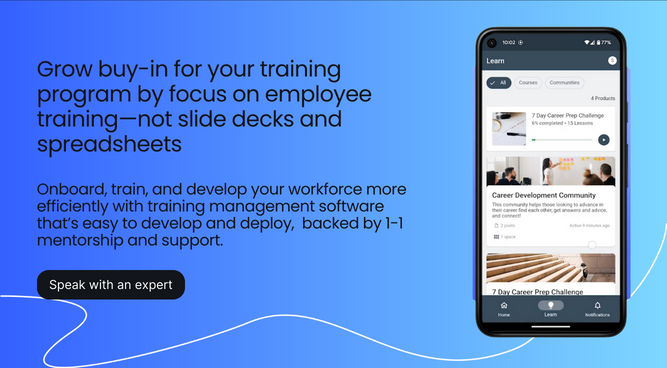Every business has to deal with the challenge of implementing mandatory training for employees – and for many it can be a real headache.
The good news is, a learning management system (LMS) can make the process much simpler. Here’s how.
How to implement mandatory training for employees
If you’re looking to provide mandatory training for your employees, here are the 6 steps you’ll need.
- Select a Learning Management System (LMS)
- Map training requirements to job roles
- Create or acquire a training curriculum
- Add users and communication expectations
- Provide certifications to participants
- Record and report training progress
Delivering mandatory training for employees is straightforward using a Learning Management System (LMS). This software allows you to plan, create and administer your mandatory training for employees all in one place.
Read on for our step-by-step guide to mandatory training for employees using an LMS.
What is mandatory training for employees?
Mandatory training for employees is training that has been determined by an organization to be essential for the maintenance of a safe and efficient working environment and service delivery. It is built on regulatory standards and policies set out by the organization. Mandatory training for employees is often known as compliance training and the two are used interchangeably.
The mandatory training you choose to implement will vary depending on your industry. For example, if you own a restaurant, mandatory training will include on-site health and safety for employees, food hygiene training and fire awareness training. You may also wish to implement mandatory team training and diversity and inclusion training for all employees and additional leadership training for managers.
Research shows that mandatory training can help to reduce accidents and improve employees’ safety attitude at work. Crucially, the effectiveness of mandatory training increases when employees have a positive attitude towards the training itself.
Related: How To Implement Employee Training And Development
What’s the difference between Statutory vs Mandatory training?
You might be wondering what is the difference between statutory vs mandatory training. Let’s break it down.
Mandatory training meaning:
Mandatory training is training that has been classed as essential by an organization. What distinguishes mandatory training from statutory training is that it is not always required by law. Instead, it is determined internally by the organization to ensure that regulatory standards are met.
Examples of mandatory training include:
- Health and safety
- First aid
- Diversity, equality, and inclusion
- Security
- Customer care
- Complaints handling
- Conflict resolution
- Record keeping
- Raising concerns
Now we’ve established what mandatory training is, here’s a look at the statutory training meaning.
Statutory training meaning:
Statutory training is training that is required by law. Unlike mandatory training, it is training that has been dictated by a statutory body and is training that an organization is legally required to provide. Statutory training for employees is aimed at helping employees maintain a safe and healthy work environment.
Here are some examples of statutory training:
- Local authority health and safety
- Fire safety awareness
- Control of substances hazardous to health
- Basic risk assessment
- Reporting of injuries, diseases, and dangerous occurrences
Related: 5 Steps to Kickstart Your Online Employee Education Program
How to deliver eLearning mandatory training with an LMS
Mandatory training is essential for the smooth and effective running of your business.
But it can be difficult to find the best way to deliver training to ensure that it doesn’t become an unnecessary drain on resources and time. This is where a Learning Management System (LMS) can be really helpful.
If you’re wondering how to implement mandatory training for employees, here are our 6 easy steps:
-
Select a Learning Management System (LMS)
The first step to implementing mandatory training is to choose a Learning Management System (LMS). To find the right LMS for your needs, it’s important to know what features and technical requirements you need for your organization. It can be helpful to check in with key stakeholders who will be responsible for creating and administering the courses to ensure that your ideas align.
Some aspects to consider include:
- Adaptability
- Ease of use
- Learner experience
- Reporting tools
- User support
Take a look at our step-by-step guide to choosing the right LMS for you.
-
Map training requirements to job roles
The types of mandatory training your employees need will vary depending on their role. Before creating and implementing your training program, it’s a good idea to map out exactly which employees require which training. For example, your sales team will need different skills to your warehouse team who will need different skills to your management.
Here it can be helpful to do a skills assessment for your workforce and analyze their training needs. It’s important to evaluate each employee’s learning journey. You can then set learning objectives and goals based on your findings. This will form the foundation for your mandatory training.
An LMS allows you to track and assess employee training on a rolling basis. In-built assessments help you to establish whether or not employees have the required standard of training needed for their job or if they need a refresher or additional training.
-
Create or acquire a training curriculum
Once you have your goals and objectives in mind, it is time to create a curriculum.
If you are looking to implement standard mandatory training, you can borrow course content for pre-established courses. With the Thinkific course builder, you can quickly upload, drag and drop content for your curriculum. This allows you to tailor a pre-built curriculum to your organization.
Alternatively, you may need to create a curriculum from scratch, especially if you are working on training that is unique to your organization. This might be the case for employee onboarding, for instance, where essential brand training is needed.
Find more help on outlining your curriculum, download this guide.
-
Add employees and communicate expectations
With an LMS, you can effortlessly add employees to your training program and create a clear learning path for them to follow. Rather than manually enrolling employees in individual courses, an LMS allows users to progress through training at their own pace following a clear and logical path.
When it comes to implementing mandatory training for employees with an LMS, communication is key. Regular communication can make a big difference to employees, helping to encourage learners to start and stick with their training. An automated email campaign is a great way to keep up communication without any extra input from course admins.
-
Provide certifications to learners
Certification is another great way to boost employee engagement when it comes to mandatory training. Getting a certificate at the end of a training program provides a sense of accomplishment and achievement. Certificates are also helpful for demonstrating to customers and external parties that your workforce are equipped with essential skills.
With an LMS, certification happens automatically when individuals finish their training program. This saves administrative time and ensures there is no delay between completing a course and receiving recognition. Learners are rewarded instantly when they complete an assessment.
There is also the option to automate recertification so that your employees are immediately re-enrolled in mandatory training after a certain period of time has passed. This can be especially helpful when it comes to training that is legally required or subject to regular changes.
-
Record and report training progress
The last and ongoing step in implementing mandatory training for employees is recording and reporting. Recording employee progress is beneficial both for your organization and your learners.
An LMS allows you to track key metrics, including total hours of training, average course scores, and engagement. From this, you can analyze which courses need attention and where you can make improvements. With clear data on the effectiveness of your training, you can get a clear picture of what works and what doesn’t, helping to improve the learning experience for future employees.
The reporting features can also be used to publicize which employees have completed the necessary training and which ones are ongoing. This information can easily be accessed by key stakeholders simply by logging into the LMS.
With all your courses, certifications, and progress monitoring in one place, an LMS makes mandatory training for employees simple.
Ready to implement mandatory training in your organization?
Thinkific is designed to help organizations build scalable training programs for their workforce using simple, intuitive tools that do the hard work for you. Don’t struggle with how to implement mandatory training for employees – with the right LMS to implement corporate training, the process can be straightforward.
Take a look at Thinkific Plus or book a call with our team to discuss our system in more detail.
This guide was published August 2021, and was updated in July 2023 to be even more useful!






